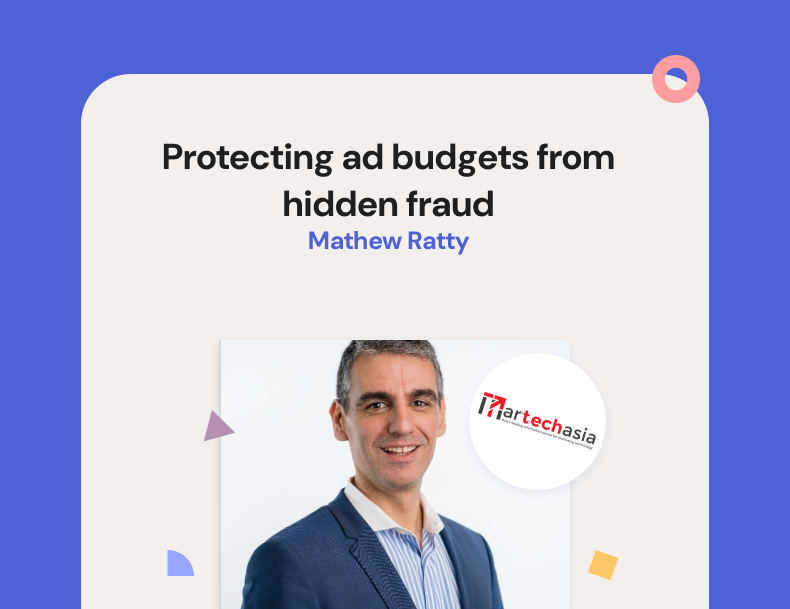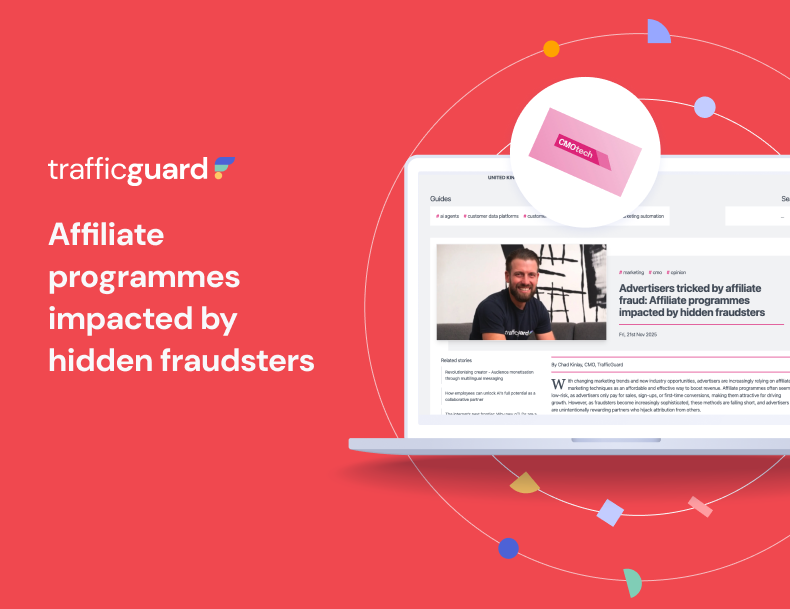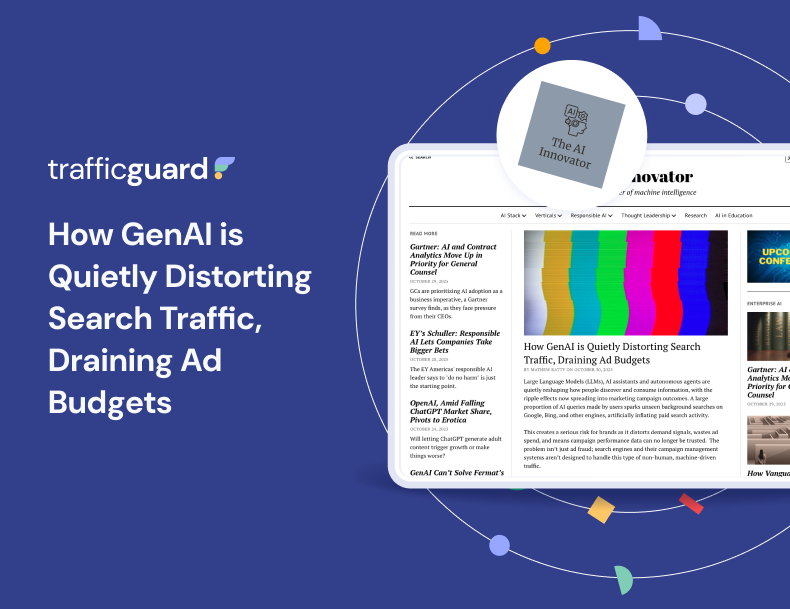Ad-vancing with AI: Interviewing Ad-Fraud Prevention Company TrafficGuard
.webp)
AI continues to dominate in the world of tech and mainstream news. We recently sat down with Mathew Ratty, Co-Founder and CEO of TrafficGuard, a platform that protects businesses from ad fraud. But there are legal questions and concerns. Artificial Intelligence-driven advertising solutions like Google's Performance Max (PMax) AI recently raised concerns among advertisers due to the Children's Online Privacy Protection Act (COPPA) violations in the US. In this exclusive interview, we'll explore the cutting-edge advancements TrafficGuard is pioneering, the responsibilities of wielding such game-changing tools, and a glimpse into the future of AI in advertising.
Neil: What are the risks for brands using ai-based advertising solutions?
Mathew: A pressing concern for performance-driven marketers lies in the inherent opacity of black box algorithms, which exacerbates the challenges associated with ad placements and allocation of resources. Black box algorithms, characterized by their lack of transparency, make it exceedingly difficult for advertisers to decipher why certain decisions are made. This lack of clarity extends to where ads are displayed and how different channel types receive various portions of impressions, clicks, or conversions. The consequence of this opacity is that advertisers may inadvertently channel their resources towards poorly performing or less desirable channels. In essence, they are navigating a digital advertising landscape blindfolded, where they cannot effectively gauge the efficacy of their campaigns. As a result, budgets can be rapidly depleted without any discernible insight into the factors driving these expenditures. This scenario can lead to not only financial risks but also a reduction in the all-important Return-On-Ad-Spend (ROAS), which is a critical metric for assessing the effectiveness of advertising efforts.
Neil: Are brands responsible for their ads and the data they collect when using ai based advertising?
Mathew: In the end, it's the responsibility of brands to ensure the appropriateness of ad placements. This responsibility hinges on having full visibility and transparency into the data they collect, rather than blindly relying on algorithms. Recent reports indicating the potential misplacement of ads targeting minors on YouTube highlight the critical need for businesses using Google's Performance Max (PMax) to conduct thorough data analysis. With a data collection filter, businesses can mitigate their exposure to unwanted data collection which is important in preventing the inadvertent collection of children’s data by businesses utilising PMax. Even tech giants can falter when it comes to maintaining brand safety. Every business's priority should be to comply with local data privacy and child protection legislation.
Neil: How can brands protect themselves when using Google’s performance max-ai?
Mathew: Brands need solutions that provide detailed reporting on campaign performance. By having a clear view of data, they gain complete control over ad budgets which has a ripple effect on the success rate of future campaigns. Alongside this, by having tools like audience targeting features that optimize the AI algorithm away from poor-quality traffic, brands can prevent invalid traffic from eating ad budgets. It is also super important to gain a comprehensive channel breakdown of spend as well as detailed conversion performance data for each channel. These tools will help you more easily identify non-genuine engagements and unlock visibility across your campaign.
Neil: Do brands have to pause their campaigns as new risks emerge?
Mathew: Currently, yes, we see this happening. But with the right solution, no, there is no need. Risks are always emerging and changing, so brands need to choose the tech that stays one step ahead. Our PMax solution involves a reporting dashboard so businesses and marketers can easily gain insight and analyze the data they need to make informed choices with their budgets. One of the main things the dashboard shows is how prevention from TrafficGuard positively impacts all campaign types. With us working behind the scenes to detect and prevent emerging risks, advertisers can visibly see the best-performing channels to identify trends and optimize on them.
Neil: What can advertisers do to ensure their data collection isn’t targeting the wrong audience?
Mathew: To ensure that data collection aligns with the right audience and avoids targeting the wrong one, advertisers can take several strategic steps. One crucial approach is refining their audience targeting signals within PMax campaigns. By doing so, they can enhance ad relevance and effectiveness, tailoring their advertisements to the individuals most likely to express interest. This proactive adjustment in targeting signals not only optimizes ad placement but also serves as a preventive measure against directing resources toward the wrong audience. Additionally, it's worth noting that solutions like TrafficGuard can further refine these signals to optimize away from invalid traffic, ensuring that advertisers do not waste their spend on audiences that do not contribute to their campaign goals. This added layer of optimization helps maximize the efficiency and cost-effectiveness of advertising efforts, aligning data collection with the right audience and preventing resources from being misdirected. Furthermore, advertisers can implement the TrafficGuard data collection filter, a valuable tool in this endeavor. Beyond enhancing data quality, this filter plays a pivotal role in preventing post-click data collection. By doing so, it mitigates the risk of inadvertently targeting an audience that doesn't meet compliance and legal requirements. This dual-pronged strategy ensures not only the effectiveness of ad campaigns but also the responsible and ethical collection of user data, thereby striking a balance between advertising goals and user privacy concerns.
Neil: How will ai in advertising grow in the future?
Mathew: The future of AI in advertising promises a transformative landscape, driven by continuous advancements in technology. One notable trend is the deepening of personalization. AI algorithms will become even more adept at understanding and predicting consumer preferences, resulting in hyper-personalized ad campaigns. These tailored advertisements will not only resonate more with audiences but also boost conversion rates, marking a significant shift towards delivering more relevant and engaging content. Another key aspect of AI's growth in advertising is the evolution of targeting capabilities. AI-powered algorithms will continue to refine their ability to identify and reach specific audience segments with precision. Advertisers will benefit from an array of sophisticated targeting options, reducing wasteful ad spend and enhancing return on investment. This level of precision will allow brands to deliver their messages directly to the consumers most likely to convert, optimizing campaign efficiency. AI will also play a pivotal role in automating various aspects of advertising, including creative optimization. Real-time analysis of ad performance data will enable AI to make dynamic adjustments to elements such as ad copy, images, and formats, ensuring optimal ad effectiveness. As AI-driven technologies continue to evolve, they will usher in a new era of streamlined content production, with AI-generated content becoming more commonplace. This not only reduces costs but also allows for more rapid adaptation to changing market dynamics and consumer preferences, making AI an indispensable tool for advertisers looking to stay competitive in the evolving advertising landscape.
Read more 👉 here.
Get started - it's free
You can set up a TrafficGuard account in minutes, so we’ll be protecting your campaigns before you can say ‘sky-high ROI’.
At TrafficGuard, we’re committed to providing full visibility, real-time protection, and control over every click before it costs you. Our team of experts leads the way in ad fraud prevention, offering in-depth insights and innovative solutions to ensure your advertising spend delivers genuine value. We’re dedicated to helping you optimise ad performance, safeguard your ROI, and navigate the complexities of the digital advertising landscape.
Subscribe
Subscribe now to get all the latest news and insights on digital advertising, machine learning and ad fraud.







